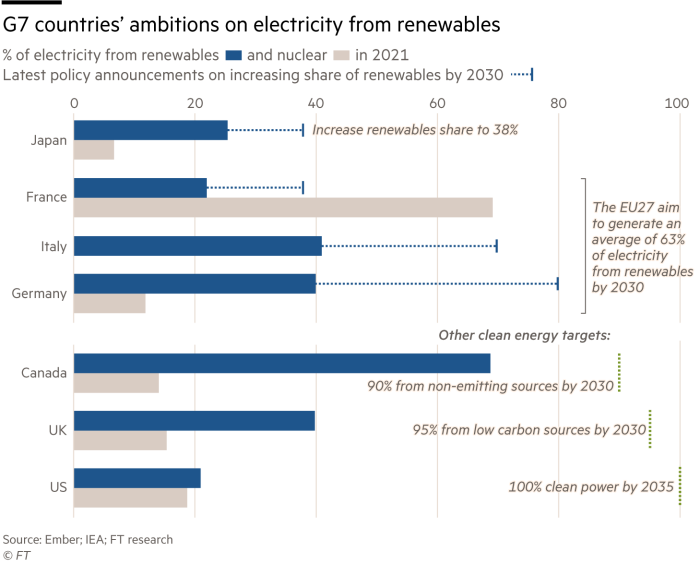
The “worrying” disparity in clean energy investments between the advanced economies and the developing nations was put into the spotlight this week, ahead of the G7 leaders meeting.
G7 economies account for about a quarter of the global energy-related carbon emissions that are behind global warming. The leaders’ meeting comes as all economies grapple to end their reliance on Russia for fossil fuel supplies as prices spike in the wake of the invasion of Ukraine.
The latest International Energy Agency world energy outlook report released last week said that while global clean energy investment had increased since the Paris climate accord was adopted in 2015, the “weakness” of clean energy investments across the developing world was “one of the most worrying trends”.
“Much more needs to be done to bridge the gap between emerging and developing economies’ one-fifth share of global clean energy investment, and their two-thirds share of the global population,” the IEA said.
The IEA cited scarce public funds, highly indebted state-owned utilities and a worsening global economic outlook as factors that made it more difficult for developing economies to invest in clean energy projects.
The agency advocated for financial and technical support, including concessional capital, private sector capital, and inflows from international carbon markets, as “crucial” for closing the gap.
The IEA also warned global investment levels in the power sector over the past three years had fallen short of the level needed to meet countries’ climate pledges, and would lead to a failure to meet the net zero global emissions target by 2050 that is required to curb climate change.
The IEA estimated global investment into power in 2022 totalled about $975bn, versus an annual requirement of $1.2tn to achieve countries’ stated policies, and $2tn to reach net zero.

It said a rapid acceleration of investment was needed in renewable technologies, alongside reduced dependency on fossil fuels, for the world to reach a 1.5C stabilisation of the rise in average global temperatures. Temperatures have already risen about 1.1C since pre-industrial times.
Power investments in emerging market economies needed to grow at a compound annual growth rate of 25 per cent to reach net zero levels, the IEA said — or twice the pace of advanced economies.
Leaders of G7 countries are expected to discuss global energy demands when they meet in Germany on Sunday. Germany’s chancellor Olaf Scholz gave assurances that climate change remained on the agenda, but the war in Ukraine has raised fears that Europe may backslide on commitments to end fossil fuel funding as coal plants and gas plants are brought into commission to compensate for the Russian supplies.
G7 countries must generate 42 per cent of their electricity by wind and solar by 2030 to keep global warming to 1.5C by 2050, the IEA has calculated.
Pressure is building on Japan, which will assume the G7 presidency next, to take a lead role in commitments to cut coal use. Tokyo agreed at the recent G7’s energy and environment ministers meeting to stop financing fossil fuel projects internationally by the end of 2022 and promised to clean up its power system by 2035. This included supporting “an accelerated global unabated coal phaseout”.
It is the only G7 country to have set a target falling short of the IEA’s recommendation of 42 per cent of energy from renewables, however, by setting itself a goal of 38 per cent.
In 2020, 70 per cent of Japan’s electricity was generated from gas and coal, with just 20 per cent coming from renewables, according to energy think-tank Ember.
“In the lead-up to the G7, many will ask if it is possible for Japan to achieve a 100 per cent clean energy system by 2035,” Ember said in a report last week. “While this target will be a challenge, it is achievable. The obvious place to start is scaling up rooftop solar and wind energy, which could help Japan create a far more secure and sustainable energy system by 2035.”

The EU has set an average target of 63 per cent by 2030 for the generation of electricity from renewable sources.
Among the leading bloc countries, Germany is aiming for 80 per cent by 2030, while Italy has a 70 per cent goal, and France just 38 per cent, because of its ample nuclear energy supplies that are regarded as “clean”.
The UK has said it will generate 95 per cent of its electricity from low carbon sources by 2030, and the US has committed to 100 per cent clean power by 2035 but is lagging behind the G7 in current renewable generation.
A US official told reporters in Washington this week that the subject of energy security would be “very much at the heart of discussions” at the G7 gathering.
Climate Capital

Where climate change meets business, markets and politics. Explore the FT’s coverage here.
Are you curious about the FT’s environmental sustainability commitments? Find out more about our science-based targets here


